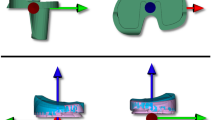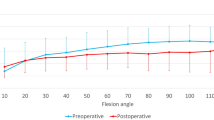Abstract
We evaluated the effect of surface geometry and retention of the posterior cruciate ligament (PCL) on screw-home movement in the knees of patients fitted with total knee replacement prostheses of five different designs (Miller/Galante [Zimmer, Warsaw, IN, USA], Mark II [Mizuho, Tokyo, Japan], Genesis PCL retaining, and cruciate substituting [Smith & Nephew/Richards, Memphis, TN, USA], and Yoshino/Shoji II [Biomet, Wiltshire, UK]). Three-dimensional motion was measured with a six-degree-of-freedom electrogoniometer (our original) during active flexion and extension of the knee. The Genesis-PCL retaining design, which has symmetric femoral and asymmetric tibial components, exhibited a pattern of screw-home movement closest to that in a normal control group (continuous external rotation between 30° flexion and extension). The implants with symmetric tibial components and the Genesis PCL-substituting design, with its asymmetric tibial articulating surface, did not replicate the screw-home movement. An asymmetric tibial articulating surface and retention of the PCL in total knee replacement may be important factors in allowing screw-home movement to occur.
Similar content being viewed by others
References
Andriacchi TP, Galante JO, Fermire RW. The influence of total knee replacement design on walking and stair-climbing. J Bone Joint Surg Am 1982;64:1328–35.
Blankevoort L, Huiskes R, De Lange A. The envelope of passive knee joint motion. J Biomech 1988;21:705–20.
Dorr LD, Ochsner JL, Gronley J, et al. Functional comparison of posterior cruciate-retained versus cruciate-sacrificed total knee arthroplasty. Clin Orthop 1988;236:36–43.
Maloney WJ, Schurman DJ. The effects of implant design on range of motion after total knee arthroplasty: Total condylar versus posterior stabilized total condylar designs. Clin Orthop 1992;278:147–52.
McLain RF, Bargar WF. The effect of total knee design on patellar strain. J Arthroplasty 1986;1:91–8.
Rittman N, Kettelkamp DB, Pryor P, et al. Analysis of patterns of knee motion walking for four types of total knee implants. Clin Orthop 1981;155:111–7.
Shiavi R, Limbird T, Frazer M, et al. Helical motion analysis of the knee-I: Methodology for studying kinematics during locomotion. J Biomech 1987;20:459–69.
Stein A, Fleming B, Pope MH, et al. Total knee arthroplasty kinematics: An in vivo evaluation of four different designs. J Arthroplasty 1988;3(Suppl):31–6.
Terajima K, Hara T, Koga Y, et al. Development of three-dimensional knee motion analysis using computed radiography system (in Japanese). Seikeigeka Biomechanics (Orthopaedic Biomechanics) 1991;13:213–7.
Terajima K, Ishii Y, Gustilo RB. Comparison of three-dimensional kinematics of total knee replacements with and without posterior cruciate ligament retention. Proc 39th Orthop Res Soc 1993 Feb 15–18; San Francisco 1993:430.
Terajima K, Tsuchiya Y, Hara T, Ishii T, Koga Y. Reliability evaluation of three-dimensional knee motion analysis using computed radiography system (in Japanese). Seikeigeka Biomechanics (Orthopaedic Biomechanics) 1991;13:219–23.
Townsend MA, Izak M, Jackson RW. Total motion knee goniometry. J Biomech 1977;10:183–93.
Warren PJ, Olanlokum TK, Cobb AG, et al. Laxity and function in knee replacements: A comparative study of three prosthetic designs. Clin Orthop 1994;305:200–8.
Werner F, Mech M, Foster D, et al. The influence of design on the transmission of torque across knee prostheses. J Bone Joint Surg Am 1978;60:342–8.
Whiteside LA, Kasselt MR, Haynes DW. Varus-valgus and rotational stability in rotationally unconstrained total knee arthroplasty. Clin Orthop 1987;219:147–57.
Author information
Authors and Affiliations
About this article
Cite this article
Ishii, Y., Terajima, K., Koga, Y. et al. Influence of total knee replacement (TKR) design on screw-home movement: Comparison of five designs for total knee replacement prostheses. J Orthop Sci 1, 313–317 (1996). https://doi.org/10.1007/BF02348841
Received:
Accepted:
Issue Date:
DOI: https://doi.org/10.1007/BF02348841




